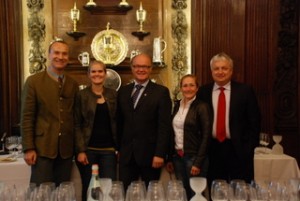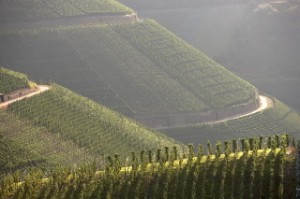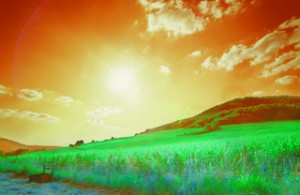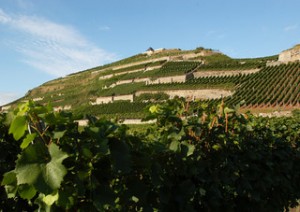German pinot noir – the pursuit of elegance

L-R: Greiner, Näkel, Fürst, Viehhauser, Heger
Top German spätburgunder (pinot noir) producers from the Ahr to Baden came to London to present their wines at a Master of Wine Masterclass on Sept 11, 2009.
Presenting their wines (north to south) were:
Meike Näkel of Weingut Mayer-Näkel (Ahr)
Dieter Greiner of Kloster Eberbach (Rheingau)
Paul Fürst of Weingut Rudolf Fürst (Franken)
Yquem Viehhauser of Weingut Bernhard Huber (Baden)
Joachim Heger of Weingut Dr. Heger (Baden)
Germany has an historic heritage of spätburgunder (pinot noir) production, stretching back 700 years and more, when Cistercian monks first took their grapes with them from Burgundy.
But the country’s ascendency to emerging world class spätburgunders largely dates from the late 1980s, as Joachim Heger of Weingut Dr. Heger in Baden explained: “We had very good wines in the old days. Then there was a period of time that was not as strong. In the 1950s, most German reds came from heated must. The wine was drinkable in March after the harvest. People added sugar to the wines so they didn’t do the malolactic fermentation. That was style of pinot noir. Nobody kept wine in bottle.
“In the late 80s and early 90s Germans came back to fermenting skins with the must, to take colour from the skins by alcohol not by heat. Since then, there has been a big development.”
In this respect, German spätburgunder is ‘newer’ than parts of the new world, though many of the best sites are matched to spätburgunder, so those centuries served a significant purpose.
Germany has the third largest plantings of pinot noir in the world (after France, and post-Sideways USA), but the variety has always played second fiddle to riesling. Spätburgunder is the most widely planted black grape variety in Germany, with 11,820ha, slowly increasing over the past five years. It accounts for 12% of the country’s total vineyard area, and 1/3rd of the black grape plantings.

Dernauer Pfarrwingert, Ahr
Ahr is the northernmost region growing pinot noir, north of the 50° line latitude. The cycle of vine-growing here is two to three weeks behind the southern parts of Baden, some 400km further south. Meike Näkel, whose father started the Mayer-Näkel estate said: “the steep slopes give a high sun intensity. The slate soils conserve heat and reflect it back, so we have higher average temperatures than the surrounding areas.”
A persistent theme for the seminar was changing viticultural and winemaking practices in the last quarter of a century. Meike said: “Before 2002, we used a maximum 11 months’ barrique ageing, but since then, it’s up to 16 months to give the wine more tannin from the oak. We also changed the maceration time to about 21 days including a short pre-fermentation maceration, and cooling time at the end of fermentation. We started making everything longer to give our wines more substance and the ability to age a little longer as well.” In the northern Ahr, the fruit/acid razor edge exists, with the winery working on those other elements of structure.
At Rheingau’s Kloster Eberbach, not so distant from the Ahr, and also on slate soils, a theme of perfumed elegance persisted in the wines. For this estate, said its managing director, Dieter Greiner “the intensity of how we work in the vineyard has changed dramatically in the last 20 years. Such as cutting grape bunches in half [to limit yield], and removing leaves.”

Assmannshausen Höllenberg, Rheingau
Some clones of spätburgunder, as in France, had been bred for quantity. So Greiner added “it depends on the clones. Some were bred for high yields. Others, like clone 18 or 20 from Geisenheim, have intense aroma but very big berries. With these clones you have to do a green harvest, even in this year when we had a strong flowering period.”
For Weingut Bernhard Huber, in Baden, Yquem Viehhauser said such vineyard work is “much more intensive than harvest. It’s 120 to 130 hours per hectare, but it’s worth it.”
In addition to cutting the bunches, Meike added “what else helps us to keep the berries small is removing some leaves during or directly after flowering. The vines get a small shock and give energy to producing more leaves and not into giving energy to the grapes to get bigger.”
Over in Franken Paul Furst is a leading spätburgunder light. Though his family have been making wine since 1638, his own expertise has changed dramatically. “When I was studying, the knowledge to make pinot noir was the same as making riesling [i.e. essentially made as a white wine]. It was the late 80s when making good red wine in Germany came to involve long maceration and deep colour.” But now, he added “the main focus in the work of my son and I is the freshness in pinot noir, the silkiness, and a good acidity which is not sour. We’re working for elegance and a fine long aftertaste.”

Centgrafenberg, Franken
Tannin management has changed towards achieving this aim. A five-to-seven day pre-fermentation cold soak is now the order of the day before fermentation in old wooden cuves using a proportion of whole bunches, which Paul said bring freshness to the wine. And for Paul “the barrel helps the wine to become balanced and round. It’s important for the wine to stay the whole 16 months on lees without rackings, and for the best wines we use 100% new French oak.”
It is Baden which has the most spätburgunder plantings, half of all of them. The southern parts of this region are 100km north of Burgundy, with more rain because of the foothills of the Black Forest. Here Weingut Bernhard Huber also use a proportion of whole clusters. Yquem said “for the 2005 Hecklinger Schlossberg we used nearly 70% whole clusters. We like the tannins of the stems working with the oak for complexity.”
A more recent change at this winery is to vinify and bottle vineyard sites separately. Yquem said: “until 2004 we had three different pinot noirs, a basic one, like a ‘villages’ then a ‘premier cru’ and a ‘grand cru’. Since 2004, we started to separate the sites. Now the Reserve [with vineyard site] at our winery is a synonym for grosses gewaches/grand cru.”
Weingut Dr. Heger is a bit further south than Huber, in the warmest part of Germany. Owner Joachim Heger chose his wines specifically to encapsulate the changing attitudes to vinification over the past decades, from the ‘high tech’ 1993 in fermenter with long maceration to extract colour and tannin, to the ‘low tech’ temperature-controlled, hand punch-down, earlier harvested fruit for greater elegance.

Ihringer Winklerberg, Baden
The 1993 had almost four weeks of maceration, with no pre-fermentation cold soak. Joachim said: “You get a good colour and it seems to be fresh but there are green tannins in the wine.” He added “It was the way we vinified the wines in this period of time.”
By 1999, he said “we didn’t want the green tannins. We fermented the wine in wooden cuves, but there was no temperature control, and it got very hot.” By 2005, temperature control is in place and grapes are harvested earlier to preserve the natural freshness of higher acidity.
As to future winemaking, Joachim said: “taking the 2005, 2006 and 2007 we have more complexity and more freshness; more silkiness, and not too much tannin but enough tannin that the wine has enough structure.”
The 2005 was looking great. I’m not convinced pinot noir can support long, dark extractions and keep its aromatic integrity.
Tasting notes
The temporal evolution on the evidence of this tasting is the aim for a more elegant, ethereal, perfumed style of pinot noir. Both vineyard work to limit yield and enhance acidity (further south)/adding structural oak (further north), as well as gentler extraction techniques in the winery are resulting in wine with a more classic paler colour, more perfume, and sufficient tannin to support, rather than constrict, the fruit-acid balancing act that is so crucial for pinot noir.
Weingut Meyer-Näkel, Ahr
Dernauer Pfarrwingert Spätburgunder Grosses Gewächs 2007
Cherry blossom perfume, elegant allspice attack. Silky texture with warm, fresh feel. Bright red fruits becoming more perfumed in the glass.
Dernauer Pfarrwingert Spätburgunder Grosses Gewächs 2007
A warmer vintage. Dry-baked cherry, lush fruit, with attractive balance. Harvested end October for that richer balance. Still very youthful with long, warm finish of succulent fruit.
Dernauer Pfarrwingert Spätburgunder Grosses Gewächs 2004
Smoky, tar nose with black cherry. Elegance and structure and fineness of acid core, with just the beginnings of a developing meaty note. Perfumed red cherry, linear acidity with the flesh of fruit surrounding the core.
Dernauer Pfarrwingert Spätburgunder Grosses Gewächs 1999
Lifted earthy notes, with sweet base texture opening up. I’m beamed up to creamy Portobello mushrooms tasting this wine. Before 2002, wines generally underwent 11 months barrel maturation, subsequently increased to nearer 16 months.
Kloster Eberbach, Rheingau
Assmannshäuser Höllenberg Spätburgunder, 2005
Gunflint smoke aroma, elegantly medium bodied with lush red cherry and strawberry fruit. Quite complete, balanced, perfumed.
Assmannshäuser Höllenberg Spätburgunder, 2003
Warmth, rumtoph fruit of the vintage, still with mouthfeel and profile of a fine wine. Compare with 1959 and 1947, also hot vintages.
Assmannshäuser Höllenberg Spätburgunder, 1989
Bricking/orange rim with aromatic wild strawberry perfume, with a palate like being enveloped in a silk blanket. And with fruit that blossoms in the medium bodied palate.
Assmannshäuser Höllenberg Spätburgunder, 1959
Brick to orange rim. Barbecue sauce smokiness giving way to sweet fruit. Remarkable to taste, balanced with expressive fruit blending with the aromatic smokiness.
Weingut Rudolf Fürst, Franken
Spätburgunder R Centgrafenberg, Grosses Gewächs 2007
Sweet spice from oak in a more modern expression of the style, with slightly grippier tannins than seen in earlier wines, above. Warm berry fruits with freshness and length.
Spätburgunder R Centgrafenberg, Grosses Gewächs 2005
Purple fruit, sweet redcurrants in spicily balanced, youthful wine of medium to full body. This wine is beginning to come into its own, filling out its body.
Spätburgunder R Centgrafenberg, Grosses Gewächs 2003
Steeped red fruits with a minty note and spicy background. Feeling the warmth of the vintage.
Spätburgunder R Centgrafenberg, Grosses Gewächs 1997
Spicy, dark berries, becoming more muscular in style.
Weingut Bernhard Huber, Baden
Hecklinger Schlossberg Spätburgunder ‘Reserve’ Qba Trocken 2006
Warm, fragrant, red cherry nose with bright, sparky fruit on the palate. Tight and focused. Very young.
Hecklinger Schlossberg Spätburgunder ‘Reserve’ Qba Trocken 2005
Bright cherry, fruit forward, beginning to open up into its quite full body.
Spätburgunder ‘Reserve’ Qba Trocken 2001
Dry-toast smoke on the nose; beautifully balanced full body with intense berry fruits. Complete and à point with all components integrated and harmonious.
Spätburgunder ‘Reserve’ Qba Trocken 1990
This was recently recorked and topped with sulphur dioxide. Not showing at its reputed best.
Weingut Dr. Heger, Baden
Achkarrer Schlossberg Spätburgunder *** Qba Trocken, 2005
Intensely perfumed, aromatic wild strawberries. Elegant, lightly medium bodied, well balanced with lengthy finish.
Ihringer Winklerberg Spätburgunder *** QbA Trocken, 2001
Perfumed, sweet fruit, with sweetness of fruit detracting a little for me.
Ihringer Winklerberg Spätburgunder *** QbA Trocken, 1999
Lifted spicy warm fruit, almost rumtoph-like.
Ihringer Winklerberg Spätburgunder *** Spätlese Trocken, 1993
Deeper colour, quite grippy with lifted savoury notes.



